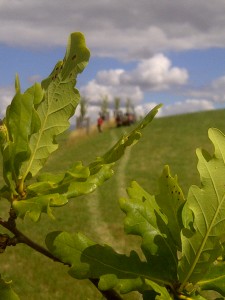Tree Facts – English oak trees at Compton Verney
Common Oak – a Fact Sheet from Compton Verney.
Plant name:
Quercus robur
Commonly known as:
English oak, or Pedunculate oak.
Origin:
Much of Europe, Caucasus and North Africa
Description:
A deciduous hardwood tree, with grey fissured bark. Leaves oval to oblong shaped with familiar lobed margins, up to 12cm long, arranged alternately – each leaf on a short stalk. Flowers in spring then bears those well-known acorn fruits in autumn.
Information:
English oak trees are to be found in many areas at Compton Verney, but the heaviest density is by far the Ice House Coppice; between the car park and the lake. Some of the oaks in the plantation are believed to date back to the eighteenth century and feature tall straight stems and shelter-giving canopies.
Many new English oaks have been planted our East Park, and are noticeable at any time of year by their substantial tree guards. The locations of these trees are based on a map from 1818, which we believe shows ‘Capability’ Brown’s planting from the previous century. The original trees were removed after the second world war.
Interesting Facts:
- Botanical Latin name Quercus robur translates as Quercus – Oak, and robur – hard/strength-wood.
- The English herbalist Nicholas Culpeper (1616-64) excused himself the need to describe the tree, ‘It [the oak] is so well known (the timber thereof being the glory and safety of this nation by sea) that it needs no description.’ – The Trees that Made Britain, Archie Miles.
- There are actually two native species of oak – the English oak (Quercus robur) and the sessile or durmast oak (Quercus petraea). The English Oak is also referred to as the pedunculate oak due to acorns being produced on long stalks or peduncles.
- Oak is one of a number of trees that can produce a second flush of leaves in late summer, known as Lammas growth, which appears around the time of the first harvest festival of the year ‘Lammas Day’ on August 1st. The fresh growth is believed to replace foliage damaged by pest attack earlier in the season.
- Oak trees are the most favoured tree by insect species, which considered alongside the tree’s attractiveness to nesting and feeding birds, bats, fungi and lichen; make even a single tree an immensely valuable ecological resource.
- Oak Apples – or oak galls, are spherical apple-shaped growths between 2 and 5 cm in diameter. They’re created by larva of tiny gall wasps. Many types of galls exists on oak trees, one type at Compton Verney is known as the Knopper gall, caused again by tiny wasps which result in a distorted acorn.
- Other types of oak tree to find at Compton Verney include Turkey, Luccombe and Red oaks, and two English oaks that have long vertical scars as a result of lightening strike!

Looking into the neighbouring North Park, a few oak trees that once formed wood pasture can still be seen.
Other tree fact sheets available:
Sources:
The Trees that Made Britain – Archie Miles
Wikipedia – Oak Apple
Wikipedia – Quercus robur



